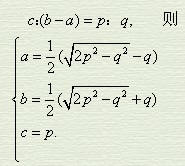Chapter 43 Chapter 10 Indeterminate Questions
The Pythagorean theorem x+y=z itself is an indeterminate problem, obviously it has countless solutions.A rational array (a, b, c) that satisfies this theorem is usually called a Pythagorean array, and in the West it is called a Pythagorean array.How to represent the Pythagorean array has been the concern of mathematicians for more than two thousand years.In the fifth and sixth centuries BC, Pythagoras set an odd number as 2a+1=m, m is a positive integer, then a=1/2(m-1), m, a+1=1/2(m +1) is the Pythagorean array; later Plato used 2m, m-1, m+1 as the Pythagorean array formula, and Euclid got √uv, 1/2(uv), 1/2(u+v) or mnpq , 1/2mn(pq), 1/2mn(p+q) represent Pythagorean arrays, obviously these expressions do not give all Pythagorean arrays.
The first time in the world to give the general solution formula of Pythagorean number is "Nine Chapters of Arithmetic" Pythagorean chapter "two people stand together".The question is: "Today there are two people standing together. The rate of A's line is seven, and the rate of B's line is three. B's line is eastward, and A's line is ten steps south and meets B in the northeast. Ask A's and B's numbers?" Obviously, A's line c +a, B row b, and (c+a): b=m:n=7:3. "Nine Chapters" first find out the rate of going south, that is, the hook rate a=1/2(mn), the rate of eastward travel, that is, the stock rate b=mn, and the rate of evil travel, that is, the chord rate c=1/2(m+n).Then, according to the known number of steps to the south, use this technique to find out the number of steps to the east and evil.Here, the three ratios of hook, strand, and string are the general solution expressions of Pythagorean numbers. The condition for its general solution is that m and n are mutually prime odd numbers, and the two examples in "Nine Chapters" all meet this condition.Diophantus of Greece is considered to be the first to give the general solution formula of the Pythagorean array in foreign countries. His formula is a=2mc/(m+1), b=ma-c=(m-1)×c/(m+1 ), if m=u/v, c=u+v, then the formula equivalent to "Nine Chapters" can be obtained.Diophantus was about the same time as Liu Hui, and three or four hundred years later than "Nine Chapters".
It is known in "Nine Chapters of Arithmetic" that the problem of Pythagorean difference and chord seeking Pythagorean later also developed into the form of Pythagorean difference rate and chord rate:
 This is another form of the general solution formula of the Pythagorean array, and its condition is that p and q are relatively prime odd numbers, and 2p-q is a complete square number.Qin Jiushao once used this formula to successfully solve the ten-degree equation construction technique of Yaodu Yuancheng.American number theory expert Dickson (Dick-son) proposed another form of the Pythagorean array in 1894:
This is another form of the general solution formula of the Pythagorean array, and its condition is that p and q are relatively prime odd numbers, and 2p-q is a complete square number.Qin Jiushao once used this formula to successfully solve the ten-degree equation construction technique of Yaodu Yuancheng.American number theory expert Dickson (Dick-son) proposed another form of the Pythagorean array in 1894:

